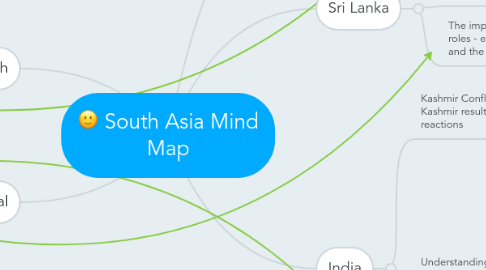
1. Bangladesh
1.1. The effects of NGOs as well as general western companies on the country specifically its clothing industry
1.2. The break from Pakistan as a result of its seperation and some linguistic barriers with the Pakistan in the north
2. Nepal
2.1. Recognizing the role the caste systems plays in Nepal as well
2.2. NGOs also played a role with the Bikas in Nepal. The problem is that the NGOs didn't understand the context of the country they were working in.
3. Pakistan
3.1. Partition- Jinnah and the desire for an Independant Pakistan.
3.1.1. 60 million of one hundred million Muslims were suppose to move- very violent-the worse affected were the women and children.
3.2. Conflict Over Kashmir, several wars, instigation of rebels against Hindu majority in the country
4. Sri Lanka
4.1. Linguistic Diversity and the role it has played in some of the violence in Sri Lanka, especially in terms of Sinhala and Tamil speaking peoples
4.2. The impact of a patriarchal society on gender roles - especially looking at the Free Trade Zone and the women that worked there.
5. India
5.1. Kashmir Conflict- The desire to secure Kashmir resulting in several violent reactions
5.1.1. JNU and Free Speech- the jailing over students over Anti- India/pro Kashmir sentiments
5.2. Understanding History and reconciling thousands of years of influence and diversity
5.2.1. The Mughal/Muslim influence and why there is such a significant Muslim influence in the Hindu Majority country
5.2.2. Looking at the British occupation and how its influence let to the division of India on ethnic/linguistic barriers as well as Gandhi and his protests
5.2.2.1. Gandhi and his influence, his non violence work toward securing an Independent India as well as his voice against parition
5.2.2.2. Remembering that it was the British that reinforced Caste and Sharia to maintain control
5.2.3. The British desired trade better trade routes and materials. Key examples: Indigo, Jewels, etc.
5.2.3.1. This could lead to violent acts of oppression by the British as well as uprisings by the people-think Sepoy Mutiny, Massacre at that well place

